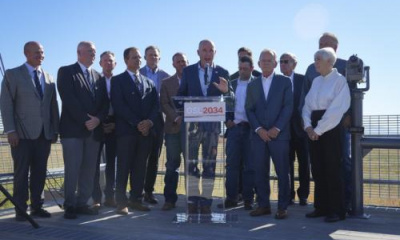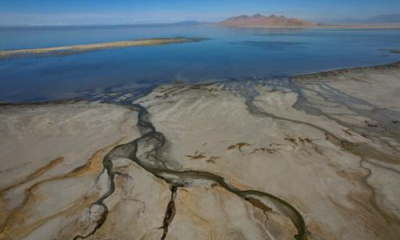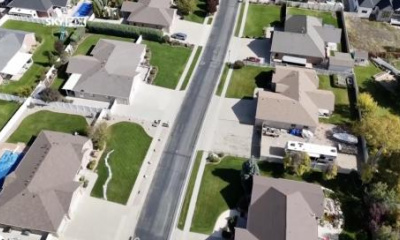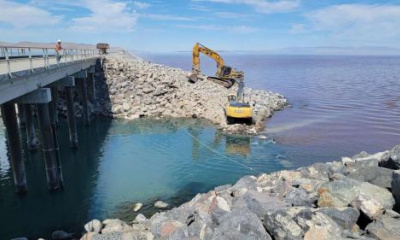SALT LAKE CITY — It appears that the Great Salt Lake's levels have peaked for the year and, if that's the case, the lake's southern arm still reached its highest level in five years but will end up lower than some projections and expectations from this year's above-normal snowpack.
The Great Salt Lake Commissioner's Office believes that the lake may have reached its spring runoff peak before it — and other bodies of water across the state — begin to recede over the summer. Its southern arm is currently listed at about 4,195 feet elevation after it briefly reached a daily average of 4,195.2 feet.
The anticipated peak is about 3 feet below the lake's minimum healthy level and about a half-foot below what Great Salt Lake deputy commissioner Tim Davis had hoped for this year.
"I would love to continue to see it come up," he said, in a briefing with reporters on Wednesday. "This is a good example of why we need to continue to work to get more water to the lake every year. ... We all need to be conserving water, dedicating it to the lake and getting it there."
The Great Salt Lake made big strides last year after falling to a record low of 4,188.5 feet elevation in 2022. Its southern arm rose to a high of 4,194.1 feet last year because of Utah's record snowpack and because the state strategically raised the berm between its northern arm to help improve salinity levels for the southern arm's ecosystem.
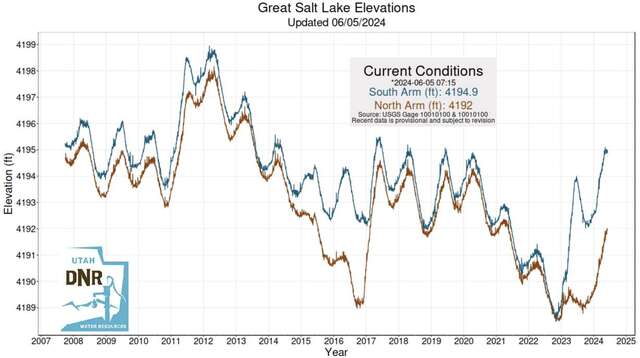
This graph shows the elevation of the Great Salt Lake's northern and southern arms between 2007 and this year. The lake's southern arm appears to have maxed out at about 4,195.2 feet this year, the highest in five years. (Photo: Utah Division of Water Resources)
The lake made more gains from this year's snowpack. While not as much as 2023, the Great Salt Lake Basin's average snowpack peaked at 23.2 inches of snow water equivalent — 3.6 inches above the median average. It also helped that most of the reservoirs within the basin remained close to full after last year's peak, so the lake benefited from controlled releases that aimed to reduce flood risks this year.
Natural Resources Conservation Service projected that the lake would at least reach 4,195 feet elevation this year, but wetter conditions in March put the lake on track to possibly reach 4,196 feet elevation. However, Jordan Clayton, a hydrologist and director of the Utah Snow Survey, advised that the projections didn't account for water diversions or factors that could impact spring snowmelt efficiency — or that water was flowing back into the northern arm above the berm, slowing down the southern arm's rise.
With only about 5% of the peak left to melt, hotter temperatures in the forecast and the irrigation season well underway, the lake's southern arm likely maxed out 1 foot above last year's peak. Its northern arm — at 4,191.9 feet elevation on Wednesday — is more than 2½ feet above where it was exactly a year ago.
Although it's not as high as Davis had hoped, he said it's still welcomed progress.
Great Salt Lake Commissioner's Office officials list 4,195 feet elevation as an intermediate goal in getting the lake back to healthy levels for its ecosystem. Great Salt Lake Commissioner Brian Steed said last month that it's a "significant" level because it's the beginning of the "transitionary zone" where adverse effects aren't as dire as two years ago.
Now that at least half of the lake is there, Davis said the office and other state entities are now focusing their attention on keeping as much of this year's gains moving forward.
"We're hoping that the lake level will maintain for as long as it can before beginning to fall," he said.
The lake normally loses about 2 feet over the summer months and the first half of fall. With hotter and drier-than-normal conditions forecast for this summer, the lake could lose more than that.
In addition to trying to secure water rights that are directed toward the lake, the commissioner's office provided a few updates to efforts to improve water flow into the lake:
- Utah Division of Forestry, Fire and State Lands is working on an update to its Great Salt Lake management plan. It's also started the process of designing a possible new causeway breach between the two lake arms.
- Utah Division of Water Resources is working to meter all secondary water sources in the basin. It's also working to implement its new Great Salt Lake Basin Integrated Plan.
- Utah Division of Water Rights is working on a "gaps analysis" with Utah State University to get better water data throughout the basin.
- Utah Division of Water Quality is working on a new "salinity limit" for discharges into the Great Salt Lake.
- Utah Division of Air Quality is monitoring dust around the lake.
State water managers said last month that they will also continue to push water conservation and agricultural water optimization efforts to help the state become more efficient with its water use.
"Those last two good water years have bought us time to take actions to make sure we get the lake to a healthy range and sustain it there," Davis said. "We can't rely upon Mother Nature to give us great snowpack every year."




